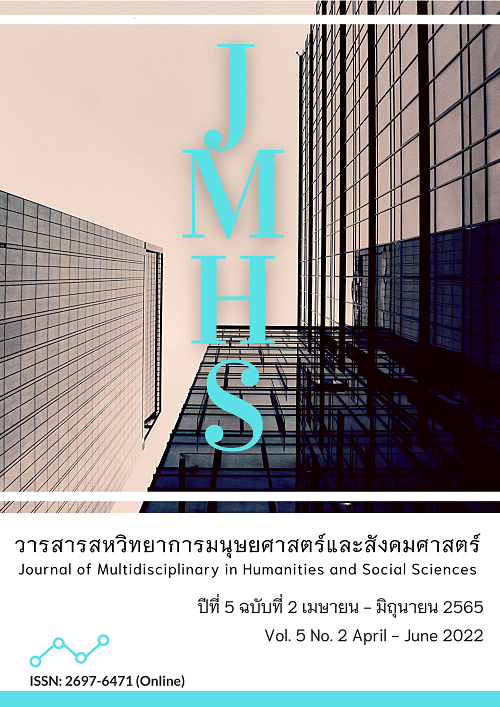An Analytical Study of the Relation Between the Seven Factors of Enlightenment in Kundaliya Sutta of Vipassana Meditation Practice
Main Article Content
Abstract
The objectives of this article were 1) to study the Seven Factors of Enlightenment in Kundaliya Sutta and 2) to study the Seven Factors of Enlightenment in Kundaliya Sutta related to Vipassana Meditation Practice by studying information from the Theravada Buddhist scriptures such as the Tripitaka, the Commentary, and other scriptures and related books, then summarized, compiled, and presented in a descriptive. The results of the study revealed that the Seven Factors of Enlightenment in Kundaliya Sutta associated with the practice of Vipassana Meditation are the qualities of the 7 Noble Person Dhammas that are the body of enlightenment. Knowing things that appear through the six anus by seeing, hearing, smelling, tasting, touching, and thinking are naturally pure as usual. The abstraction that is born with the mind is the contract, acting as a means of knowing, and Sankhara, acting to manipulate the response, causing the mind to not pass. There is only suffering, but the cultivation of the Seven Factors of Enlightenment will help the mind to return to its pure state through the process of cultivating mindfulness that recognizes the present state of Dharma as the main principle. When the practitioner regularly meditates, they will be freed from the taint without clinging to the four foundations of mindfulness. One develops the Seven Factors of Enlightenment that one develops like this and makes much of it, thus completing knowledge and liberation, to quench, to calm, to full knowledge, to enlightenment, to Nirvana.
Article Details

This work is licensed under a Creative Commons Attribution-NonCommercial-NoDerivatives 4.0 International License.
Views and opinions appearing in the Journal it is the responsibility of the author of the article, and does not constitute the view and responsibility of the editorial team.
References
ชัยชาญ ศรีหานู. (2564). วิเคราะห์คำสอนวิปัสสนาในเตภูมิกถาที่มีผลต่อคตินิยมเชิงพุทธในสังคมไทย. วารสาร มจร บาฬีศึกษาพุทธโฆสปริทรรศน์, 7(1), 12-26.
พรมงคล ฉันท์รัตนโยธิน. (2561). โพชฌงค์ 7 กับพุทธจิตเสริมสุขภาพ. วารสารพุทธจิตวิทยา, 3(1), 29-37.
พระกัมมัฏฐานาจริยะ พระปัณฑิตาภิวงศ์. (2551). รู้แจ้งในชาตินี้. (พิมพ์ครั้งที่ 8). กรุงเทพฯ: สหธรรมิก.
พระธรรมธีรราชมหามุนี (โชดก าณสิทธิ). (2550). คำบรรยายวิปัสสนากรรมฐาน. กรุงเทพฯ: ประยูรวงศ์พริ้นท์ติ้ง.
พระพรหมคุณาภรณ์ (ป.อ. ปยุตฺโต). (2554). พุทธธรรม ฉบับปรับขยาย. (พิมพ์ครั้งที่ 47). กรุงเทพฯ: ผลิธัมม์.
พระพุทธโฆสเถระ. (2554). คัมภีร์วิสุทธิมรรค. (สมเด็จพระพุฒาจารย์ (อาจ อาสภมหาเถร), แปล). (พิมพ์ครั้งที่ 10). กรุงเทพฯ: ธนาเพรส.
พระมหานพดล นวตลปญฺโญ, พระครูสุธีคัมภีรญาณ (ประมวล) และ พระมหามิตร ฐิตปญฺโญ. (2564). รูปแบบการปฏิบัติธุดงควัตรของพระสงฆ์ในลุ่มแม่น้ำโขง (ไทย-ลาว). วารสารศิลปการจัดการ, 5(2), 325-339.
พระสมชาย บัวแก้ว, พระมหาบุญศรี วงค์แก้ว และ สุเชาวน์ พลอยชุม. (2564). อภิสมาจาร: กระบวนการพัฒนาบุคลิกภาพตามแนวพระพุทธศาสนา. วารสารศิลปการจัดการ, 5(3), 895-907.
พระโสภณมหาเถระ (มหาสีสยาดอ). (2548). มหาสติปัฏฐานสูตร ทางสู่พระนิพพาน. กรุงเทพฯ: ไทยรายวันการพิมพ์.
มหาจุฬาลงกรณราชวิทยาลัย. (2539). พระไตรปิฎกภาษาไทย ฉบับมหาจุฬาลงกรณราชวิทยาลัย. กรุงเทพฯ: โรงพิมพ์มหาจุฬาลงกรณราชวิทยาลัย.
มหาจุฬาลงกรณราชวิทยาลัย. (2552). อรรถกถาภาษาไทย ฉบับมหาจุฬาลงกรณราชวิทยาลัย. กรุงเทพฯ: โรงพิมพ์มหาจุฬาลงกรณราชวิทยาลัย.
สมเด็จพระพุทธโฆษาจารย์ (ป. อ. ปยุตฺโต). (2561). พจนานุกรมพุทธศาสตร์ ฉบับประมวลธรรม. (พิมพ์ครั้งที่ 41). กรุงเทพฯ: ผลิธัมม์.
อรชร ไกรจักร์, เเม่ชีกฤษณา รักษาโฉม และ พระมหาวรัญธรณ์ ญาณกิตฺติ. (2564). บุคลิกภาพของพระภิกษุตามหลักเวสารัชชกรณธรรม. วารสาร มจร บาฬีศึกษาพุทธโฆสปริทรรศน์, 7(3), 113-125.
Damnoen, P.S. (2021). The Development of Student Characteristics in According to the Nawaluk Framework of the Buddhist integration of Buddhapanya Sri Thawarawadee Buddhist College. Asia Pacific Journal of Religions and Cultures, 5(2), 126-135.
Pandita, S. U. (1993). In This Very Life. (2nd ed). Kandy: Buddhist Publication Society.
Sayadaw, M. (1992). The Satipatthana Vipassana Meditation. Yangon: Buddha Sasana Nuggaha Organization.
Tan, C. C., & Damnoen, P. S. (2020). Buddhist Noble Eightfold Path Approach in the Study of Consumer and Organizational Behaviors. Journal of MCU Peace Studies, 8(1), 1–20.


